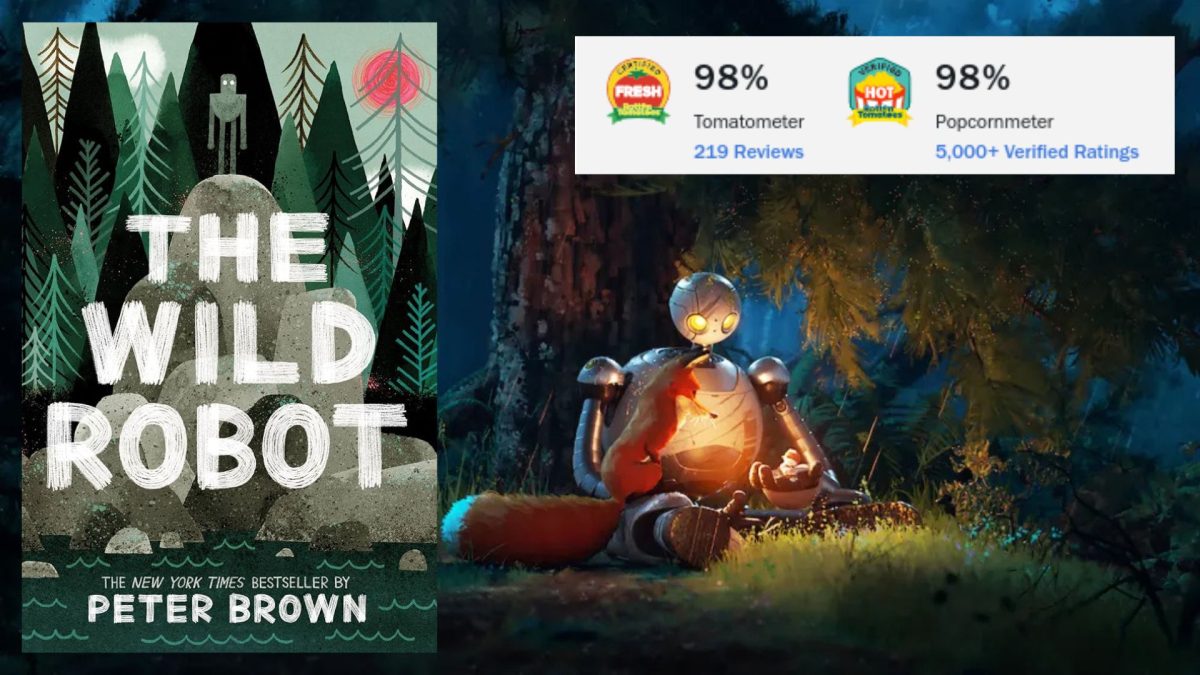The Wild Robot, released in September of 2024, is a short but endearing movie about a robot named Roz who is stranded on an isolated island and has to learn to live with wildlife while overcoming her programming. This film was inspired by a series of books under the same name initially released in April 2016 by Peter Brown, the first two of which were adapted into the movie.
A general criticism of the movie was how the first trailer portrayed the film: a silent movie with environmental messages akin to the first half of Pixar’s Wall-E. The later trailers broke this illusion as the celebrity voices of the cast, such as Kit Conner, Mark Hamill, and Pedro Pascal, were revealed, a choice many hopeful audience members found distasteful. However, following the movie’s theatrical release, many of these critics retracted their words and came to value the voices, acknowledging that they undoubtedly enhanced the watching experience through their emotional delivery and, in Roz’s case, a representation of character development.
Roz is initially portrayed as a very straightforward and by-the-book figure, with her robotic voice representing her static nature. However, as the movie progresses, Roz’s voice becomes more diverse, developing “humanity” the longer she spends with the island’s wildlife. This subtle yet effective method of characterization, portrayed flawlessly by her voice actor, Lupita Nyong’o, communicates her character growth without drawing direct attention to it. Had the movie been silent as people initially believed, a major part of Roz’s development would’ve been lost, creating a lackluster main character that wouldn’t have had as much charm as she did. In the end, Roz learns to value life on the island, forming deep bonds with the same animals who had initially feared her.
Beyond Roz, the other characters of the movie, such as Fink and Brightbill, were just as charming and comedic, filling their roles as both main and side characters flawlessly. In many movies, it’s not uncommon for the talking animal sidekick to become unnecessary or weigh down the story, but in The Wild Robot, the animals are crucial to the development of both Roz and the world building. Surprisingly, the filmmakers were able to balance the side and main characters so that one did not overpower the other, creating a much-needed evenness for a cast that would’ve otherwise lacked depth.
If criticism had to be raised, the character development of Brightbill, a goose Roz is tasked with raising after killing his family in an accident, felt too rushed for his actions later in the movie to feel earned. Brightbill, due to his unique upbringing under Roz’s care, struggles with interacting with others of his kind, a barrier he spends the remainder of the movie trying to overcome. In addition to this goal, Roz also tasks herself with teaching Brightbill how to swim and fly before he has to migrate away from the island for winter, all of which he accomplishes by the film’s midpoint. His initial progress is handled appropriately and realistically, but toward the end of the movie, he is forced into a leadership position that he showed no indication of preparing for earlier. This brings into question the true purpose of Brightbill’s development, which was portrayed as him simply learning to fit in but suddenly becoming him learning to be a leader.
The Wild Robot, though released during a drought of quality animated films, is a masterful adaptation of a beloved novel that fills the hole left by Disney and Pixar in recent years. Without question, this movie has deserved all of the praise it has received over the weeks. Director Christopher Sanders has undoubtedly created his magnum opus of the decade, leaving other animation companies with an example of what animation can and should be: a work of art designed to be appreciated by all.


